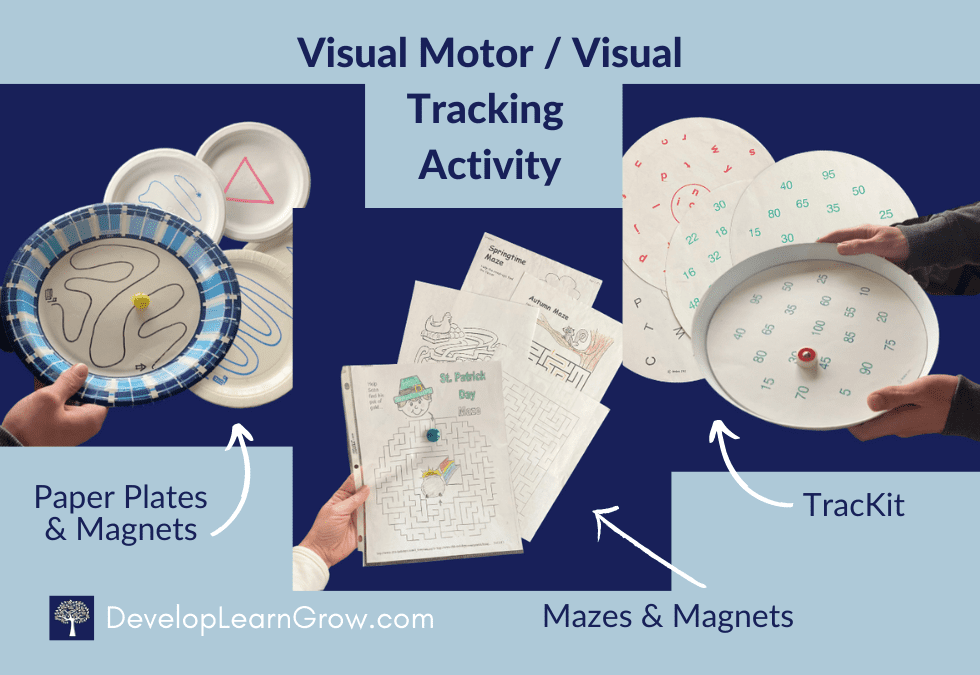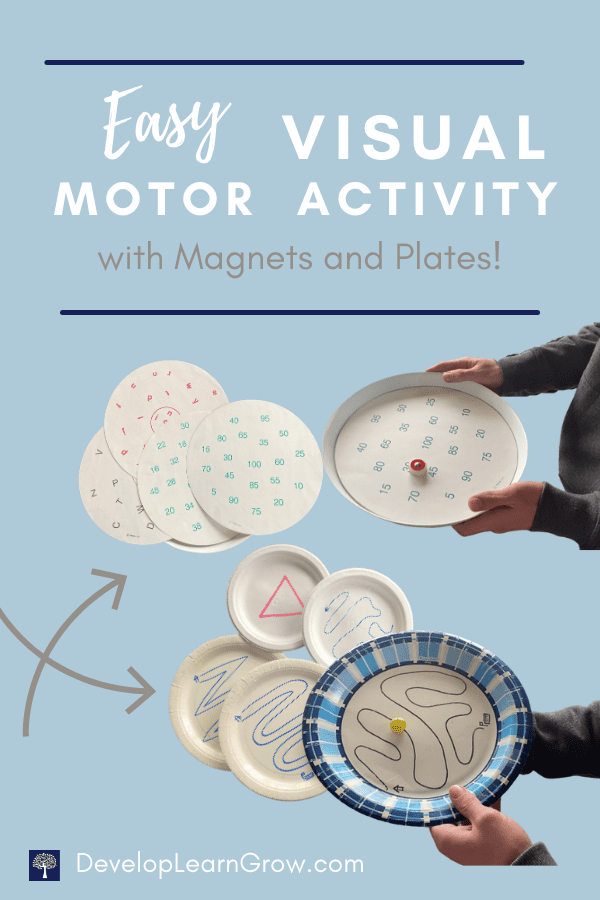This simple visual motor skills activity is easy to use during math and language arts. It’s fun for kids and it addresses several important skills needed for learning tasks!
Looking for a fun activity that addresses grasping, hand dominance, and tactile/kinesthetic awareness?
And, visual tracking, bilateral coordination, crossing midline, and shoulder stability…
Also… motor planning, grading of movements, and concentration…
Even visual focus, visual scanning, visual discrimination, and memory / sequential memory…
…all activities that are important for the brain. All skills that help kids strengthen learning pathways.
And did I mention that you can use it during language arts and math? Which is perfect, because it supports skills needed for both subjects!
I’m excited to share it – it’s one of my favorites that I’ve adapted and used in a variety of ways for kids to support learning!
First, I’ll explain where I got the idea for the activity (TracKit.) Then, I’ll share ways to adapt it and how to make your own version of the activity.
TracKit by Mary Benbow – A Cool Visual Motor Activity
Mary Benbow is an occupational therapist who created TracKit. I purchased one many years ago and still have it. I love using it with students!
[You can check out the set and purchase it on Therapro.com – however, it’s easy to create your own version!]
TracKit contains a large round plastic tray, 5 reversible cards and a small slider.
The large circular cards fit into the tray. They contain pictures, letters and numbers.
The slider is a plastic disc with a ball inside. Students hold the tray with two hands and tip it gently to move the slider to various targets on the cards.
TracKit requires stabilization and precise controlled movements as the slider moves around. I’ve found this to be difficult for most younger kids I work with. So, I use the magnet…
Adapting the Visual Motor Activity / TracKit
Holding the tray and carefully tipping it to stop the slider at the targets can be challenging for some students. I’ve found ways to adapt the activity or even better, create DIY versions of it.
If using the original TracKit tray, instead of using the slider- you can have students use two strong magnets.
Hold one magnet below the tray and slide it around to move the magnet on top.
For example, a right-handed student holds the tray with their left hand. Then, he / she grasps onto a magnet under the tray. As the magnet is slid under the bottom of the tray, it moves the magnet on top of the tray.
This is important for bilateral coordination.

Creating Your Own Versions of the Visual Motor Skills Tracking Activity
There are endless possibilities for making your own version of this activity. I find what I have laying around and adapt it as needed.
I’ve used plain white paper plates (and write or draw on them with marker or pen.)
Sheets of paper placed inside a page protector work as an easy alternative. For a warm-up before a therapy session, I’ll print out a seasonal maze and place it inside the plastic cover.
Laminating sheets are an easy way to protect the paper and help the magnet slide easier over the paper.
Just magnets and thick, oak tag or card stock paper work for this activity. Plastic trays with paper placed on top (taped down if needed) also work well.
For more magnet activities, check out this article: Magnet Experiments and Activities for Kids.
How to Use the Visual Motor Magnet Activity during Math and Language Arts
I’ve used the TracKit cards with kids. I’ve also made my own papers, depending on what academic support a child needs. My favorite version is a large plastic tray… this helps kids cross midline with the magnet under the plate.
You can easily make any of these for your kiddos! It’s a fun way for kids to learn… without them even realizing it!
Use this as a “warm-up” activity to get the eyes focusing and ready for other learning tasks. Or add it to one of your learning centers.
If a child needs a bit of a break, I don’t challenge them with a thinking task that’s too hard, I’ll pick an easier one to keep it fun.
Important skills are still being addressed!
When using letter cards, the following skills can be addressed:
- Identifying letters (following directions, “find the n”)
- Sequencing the alphabet
- Spelling names or words
- Identifying cursive letters (many kids can’t recognize or read cursive)
- Discriminating b from d
- Peer interaction (one student says a spelling word, the other spells)
When using the number cards, you can focus on the following skills:
- Sequencing numbers to count
- Counting by 2’s or 5’s
- Finding answers to math problems
- Counting backwards
- Peer interaction (one student holds up or says a problem, the other moves the magnet to the answer)
Make your own cards or plates and have kids work on:
- Tracing shapes
- Proper letter formation
- Motor control through mazes
- Matching capital to lowercase
- Tracking complex crossing paths
Use these as center activities or at home for practice.

Why I LOVE this Visual Motor Magnet Activity
One, kids of all ages love it! It’s fun.
Two, this activity addresses numerous skills.
It requires bilateral coordination and upper body stabilization as the non-dominant hand holds the tray or plate, while the dominant hand grasps the magnet underneath.
A small magnet size encourages grasping using only the skill fingers (thumb, index and middle fingers.) This helps strengthen and stabilize the fingers within the hand.
Kids are often so reliant on visual input during learning (as noted in the Tactile Learning Activity post.) This visual motor activity improves kinesthetic awareness as the hand below the plate finds, grasps and moves the magnet. In turn, this stimulates a different part of the brain.
A child focuses, visually scans, and visually tracks the targets and magnet during this game. Additional visual skills are also addressed depending on the learning skill. Visual discrimination: locating capitals from lowercase, b’s from d’s, etc. Visual sequential memory: sequencing the alphabet.
If the tray or plate is large enough, the dominant hand and eyes also cross the midline of the body. (If the child doesn’t twist or turn his / her trunk or head.)
Additional Benefits of Using a Slider and a Tray during the Visual Motor Activity
Using the tray and slider requires more concentration. As the child holds the tray with two hands, it adds a motor planning and grading of movements challenge.
The shoulders stabilize the arms as smaller movements tip the tray.
In summary, this simple visual motor activity supports academic learning tasks while also addressing many developmental skills!!
Share this on your favorite social media network! Pass along to teachers and parents.
If you like this simple activity, be sure to check out these posts:
Easy Visual Tracking Activities Using the Infinity Loop (and Flashcards)
15+ Activities to Improve Visual Skills for Learning
Simple DIY Math Manipulatives for Tactile and Kinesthetic Learning


0 Comments